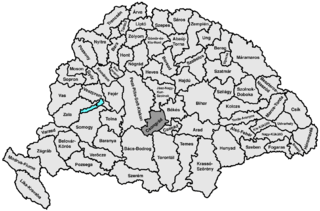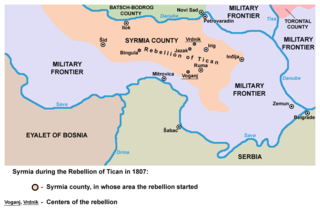 W
WApatin Brewery, a member of the Molson Coors Europe, is a Serbian brewery based in Apatin. It is majority owned by the American company Molson Coors.
 W
WBács-Bodrog County was an administrative county (comitatus) of the Kingdom of Hungary from 1802 century to 1920. Most of its territory is currently part of Serbia, while a smaller part belongs to Hungary. The capital of the county was Zombor.
 W
WThe Battle of Slankamen was fought near Slankamen in the Ottoman Sanjak of Syrmia on August 19, 1691, between the Ottoman Empire, and the Imperial Army, the personal forces of the Holy Roman Emperor, together with the Reichsarmee of the Holy Roman Empire of the German Nation and Austrian-Hungarian-Croatian-Serbian combined forces under the command of Louis William, Margrave of Baden-Baden, as part of the Great Turkish War.
 W
WCsongrád was an administrative county (comitatus) of the Kingdom of Hungary. Its territory, which was smaller than that of present-day Csongrád-Csanád County, is now part of Hungary, except a very small area which belongs to Serbia. The capital of the county was Szentes.
 W
WDeclaratory Rescript of the Illyrian Nation was issued on 16 July 1779 by Maria Theresa, Dowager-Empress and Queen of Hungary (1740-1780). It was a royal rescript, issued in response to a series of petitions made by Eastern Orthodox subjects of the Habsburg Monarchy, regarding the regulation of their religious freedom and ecclesiastical autonomy. The document was the result of a process, initiated by previously issued Regulamentum privilegiorum (1770) and Regulamentum Illyricae Nationis (1777), both of them replaced by the royal rescript of 1779.
 W
WDélvidék is a historical political term referring to varying areas in the southern part of what was the Kingdom of Hungary. In present-day usage, it often refers to the Vojvodina region of Serbia.
 W
WThe District of Potisje was an administrative territorial entity of the Habsburg Monarchy. It was formed in 1751 with headquarters in Stari Bečej, and existed for almost one century.
 W
WThe Privileged District of Velika Kikinda was an administrative territorial entity of the Habsburg Monarchy between 1774 and 1876. It was an autonomous area centered around the town of Velika Kikinda, and mainly inhabited by ethnic Serbs.
 W
WThe Great Migrations of the Serbs, also known as the Great Exoduses of the Serbs, refers mainly to two large migrations of Serbs from various territories under the rule of Ottoman Empire to regions under the rule of Habsburg Monarchy in the 17th and the 18th centuries.
 W
WVikentije Jovanović was the Serbian Orthodox Metropolitan of Belgrade and Karlovci from 1731 to 1737, as Vikentije II. During his diplomatic mission in Vienna in 1734, he was given permission by Emperor Charles VI to establish a hussar regiment constituted solely of Serbs and Croats. It was officially named Illyrian-Rascian regiment and inaugurated on June 16, 1735, in a grand ceremony officiated by Vikentije. The ceremony took place outside Budim where the banners which were used symbolized his importance in the Austrian Empire, but also the dual symbolism of East and West; dual coats of arms on their spears, two languages in their inscriptions, and the use of Eastern iconography and Western emblematic imagery. Vikentije's hussars went on to fight in the Austro-Russian–Turkish War (1735-1739).
 W
WThe Kingdom of Croatia-Slavonia was a nominally autonomous kingdom and constitutionally defined separate political nation within the Austro-Hungarian Empire, created in 1868 by merging the kingdoms of Croatia and Slavonia following the Croatian–Hungarian Settlement of 1868. It was associated with the Hungarian Kingdom within the dual Austro-Hungarian state, being within the Lands of the Crown of St. Stephen, also known as Transleithania. While Croatia had been granted a wide internal autonomy with "national features", in reality, Croatian control over key issues such as tax and military issues was minimal and hampered by Hungary. It was internally officially referred to as the Triune Kingdom of Croatia, Slavonia and Dalmatia, also simply known as the Triune Kingdom, and had claims on Dalmatia, which was administrated separately by the Austrian Cisleithania. The city of Rijeka, following a disputed section in the 1868 Settlement known as the Rijeka Addendum, became a corpus separatum and was legally owned by Hungary, but administrated by both Croatia and Hungary.
 W
WThe Kingdom of Hungary was a monarchy in Central Europe that existed from the Middle Ages into the 20th century. The Principality of Hungary emerged as a Christian kingdom upon the coronation of the first king Stephen I at Esztergom around the year 1000; his family led the monarchy for 300 years. By the 12th century, the kingdom became a European middle power within the Western world.
 W
WKrassó-Szörény was an administrative county (comitatus) of the historic Kingdom of Hungary. Its territory is now mostly located in south-western Romania, with one small part which is located in Serbia. The capital of the county was Lugos.
 W
WMagyarization, after "Magyar"—the autonym of Hungarians—was an assimilation or acculturation process by which non-Hungarian nationals came to adopt the Hungarian culture and language, either voluntarily or due to social pressure, often in the form of a coercive policy.
 W
WThe Metropolitanate of Karlovci was a metropolitanate of the Serbian Orthodox Church that existed between 1708 and 1848 (1920). Between 1708 and 1713 it was known as the Metropolitanate of Krušedol, and between 1713 and 1848 as the Metropolitanate of Karlovci. In 1848, it was transformed into the Patriarchate of Karlovci, which existed until 1920, when it was merged with Metropolitanate of Belgrade and other Serbian church provinces to form the united Serbian Orthodox Church.
 W
WSvetozar Miletić was a Serbian lawyer, journalist, author, politician, mayor of Novi Sad, and the political leader of Serbs in Vojvodina. Svetozar Miletić was one of the most influential ideological and political leaders of the Serbs living in the Habsburg lands.
 W
WThe Military Frontier was a borderland of the Habsburg Monarchy and later the Austrian and Austro-Hungarian Empire. It acted as the cordon sanitaire against incursions from the Ottoman Empire.
 W
WMolin was a village in Banat, Serbia. The village was founded in 1832 and existed until 1961. It was located in the Nova Crnja Municipality, Central Banat District, Vojvodina Province. The village was abandoned because of groundwater. Today the location of the former village is Molin Forest, which is used as a hunting ground.
 W
WThe Patriarchate of Karlovci or Serbian Patriarchate of Sremski Karlovci, was a patriarchate of the Serbian Orthodox Church that existed between 1848 and 1920. It was formed in 1848, when Metropolitanate of Karlovci was elevated to the rank of patriarchate. The Patriarchate of Karlovci existed until 1920, when it was merged with Metropolitanate of Belgrade and other Serbian ecclesiastical provinces to form the united Serbian Orthodox Church. The seat of the Patriarchate was in Karlovci.
 W
WRascians was a common exonym for Serbs during the late medieval and the early modern period. It was used most frequently in the Kingdom of Hungary, and also in the Habsburg Monarchy. The term was derived from the Latinized name for the central Serbian region of Raška. In medieval and early modern Western sources, exonym Rascia was often used as a designation for Serbian lands in general, and consequently the term Rasciani became one of the most common designations for Serbs. Because of the increasing migratory concentration of Serbs in the southern Pannonian Plain, since the late 15th century, those regions also became referred to as Rascia, since they were largely inhabited by Rasciani (Rascians). Among those regions, term Rascia (Raška) was most frequently used for territories spanning from western Banat to central Slavonia, including the regions of Syrmia, Bačka, and southern Baranja. From the 16th to the 18th century, those regions were contested between the Ottoman Empire and the Habsburg Monarchy, and today they belong to several modern countries.
 W
WA set of revolutions took place in the Austrian Empire from March 1848 to November 1849. Much of the revolutionary activity had a nationalist character: the Empire, ruled from Vienna, included ethnic Germans, Hungarians, Slovenes, Poles, Czechs, Slovaks, Ruthenians (Ukrainians), Romanians, Croats, Venetians (Italians) and Serbs; all of whom attempted in the course of the revolution to either achieve autonomy, independence, or even hegemony over other nationalities. The nationalist picture was further complicated by the simultaneous events in the German states, which moved toward greater German national unity.
 W
WArsenije IV Jovanović Šakabenta was the Archbishop of Peć and Serbian Patriarch from 1725 to 1737 and Head of the Serbian Orthodox Church in Habsburg Monarchy from 1737 to his death in 1748.
 W
WThe Voivodeship of Serbia and Banat of Temeschwar or Serbian Voivodeship and the Banate of Temes, known simply as the Serbian Voivodeship, was a crownland of the Austrian Empire that existed between 1849 and 1860.
 W
WThe Serbian Free Corps, known simply as frajkori, was a volunteer militia composed of ethnic Serbs, established by the Habsburg Monarchy, to fight the Ottoman Empire during the Austro-Turkish War (1787–91). The conflict with Turkish forces ultimately proved inconclusive. The rebellion in the Sanjak of Smederevo and militia's operations resulted in the period of Habsburg-occupied Serbia, which took place from 1788 to 1792. Ultimately, the Serbian volunteer corps had the legacy of promoting the creation of future paramilitaries, such as during the First Serbian Uprising.
 W
WThe Serbian Vojvodina was a short-lived self-proclaimed Serb autonomous province within the Austrian Empire during the Revolutions of 1848, which existed until 1849 when it was transformed into the new (official) Austrian province named Voivodeship of Serbia and Banat of Temeschwar.
 W
WThe Kingdom of Slavonia was a province of the Habsburg Monarchy and the Austrian Empire that existed from 1699 to 1868. The province included northern parts of present-day regions of Slavonia and Syrmia. The southern parts of these regions were part of the Slavonian Military Frontier, which was a section of the Military Frontier.
 W
WSyrmia County was a historic administrative subdivision (županija) of the Kingdom of Croatia-Slavonia. Croatia-Slavonia was an autonomous kingdom within the Lands of the Crown of Saint Stephen (Transleithania), the Hungarian part of Austria-Hungary. The region of Syrmia is today split between Croatia and Serbia. The capital of the county was Vukovar.
 W
WCounty of Temes was an administrative county (comitatus) of the Kingdom of Hungary. Its territory is now in southwestern Romania and northeastern Serbia. The capital of the county was Temesvár, which also served as the kingdom's capital between 1315–1323.
 W
WThe Tican's rebellion was a rebellion of the Syrmian peasants against feudal relations in society. The rebellion started in April 1807 on the estate of Ruma of earl Karlo Pejačević and estate of Ilok of earl Odescalchi. The reason for the rebellion was large increase of feudal tributes and dissatisfaction because of land regulation.
 W
WTorontál was an administrative county (comitatus) of the Kingdom of Hungary. Its territory is now divided between Serbia and Romania, except a small area which is part of Hungary. The capital of the county was Nagybecskerek, the current Zrenjanin.
 W
WThe Battle of Zenta, was fought on 11 September 1697, near Zenta, Ottoman empire, between Ottoman and Holy League armies during the Great Turkish War. The battle was the most decisive engagement of the war, and it saw the Ottomans suffer an overwhelming defeat by an Imperial force one third as large commanded by Prince Eugene of Savoy.